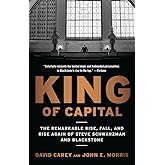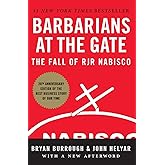Buy new:
$50.31$50.31
Save with Used - Good
$14.61$14.61

Download the free Kindle app and start reading Kindle books instantly on your smartphone, tablet, or computer - no Kindle device required.
Read instantly on your browser with Kindle for Web.
Using your mobile phone camera - scan the code below and download the Kindle app.

The Buyout of America: How Private Equity Will Cause the Next Great Credit Crisis Hardcover
Purchase options and add-ons
- LanguageEnglish
- PublisherPortfolio Hardcover
- Dimensions6.3 x 1.05 x 9.3 inches
The Amazon Book Review
Book recommendations, author interviews, editors' picks, and more. Read it now.
Customers who viewed this item also viewed
Product details
- ASIN : B003IWYH7E
- Language : English
- Item Weight : 14.4 ounces
- Dimensions : 6.3 x 1.05 x 9.3 inches
- Customer Reviews:
About the author

Discover more of the author’s books, see similar authors, read book recommendations and more.
Customer reviews
Customer Reviews, including Product Star Ratings help customers to learn more about the product and decide whether it is the right product for them.
To calculate the overall star rating and percentage breakdown by star, we don’t use a simple average. Instead, our system considers things like how recent a review is and if the reviewer bought the item on Amazon. It also analyzed reviews to verify trustworthiness.
Learn more how customers reviews work on AmazonCustomers say
Customers find the book worth reading, interesting, and well-documented. They also describe it as an extraordinary, important book that should be widely read. Readers appreciate the great clarity and insight it provides.
AI-generated from the text of customer reviews
Customers find the book worth reading, interesting, and well-documented. They say it's a good overview for readers who want to know more about private equity.
"...I rate it as one of the more important books I have read in recent times." Read more
"...In short, the book is a good overview for readers who want to know more about Private Equity firms. I recommend it...." Read more
"...Very well written; very well researched. Makes an excellent casefor the chaotic influence of private equity on our economy...." Read more
"...This is a very valuable, well-documented read from an industry insider." Read more
Customers find the book extraordinarily important, well-researched, and well-written. They say it has a great and important clarifying impact on them. Readers also mention it provides great insight into the operational impact of private equity.
"...understood before reading the book, but the book had a great and important clarifying impact upon me...." Read more
"...Very well written; very well researched. Makes an excellent casefor the chaotic influence of private equity on our economy...." Read more
"...Every chapter is well researched and the author makes his case exceptionally well...." Read more
"Excellent Read on the operational impact of Private Equity." Read more
-
Top reviews
Top reviews from the United States
There was a problem filtering reviews right now. Please try again later.
In short, the book is a good overview for readers who want to know more about Private Equity firms. I recommend it.
PE firms are not Hedge funds. Those take investor money and invest it in a variety of schemes to increase the value of the money in the fund and for the investors. PE firms are not venture capitalist firms, either. Those entities invest in companies with the goal of making them stronger and increasing their worth, without the need of excessive debt acquired in the process.
Private Equity firms, in contrast, put down cash, usually no more than 30-40% of the purchase price of the acquired company, to acquire a company. The company, itself, finances the rest of the money required for the purchase. Within five years, the Private Equity firm plans to sell the company. Frequently, it sells to yet another PE firm.
For PE firms the whole exercise is to make money. Pure and simple. The more the PE firm can sell the acquired company for, or pull out of the company before it is sold, the better. Neither the long-term success of the company nor the status or future of its workers are much of a concern for the PE firm.
In the 1990s, the PE industry was known for "leveraged buyouts." Per the book, the industry simply changed its name to "private equity." PE was red hot in 2007, growing substantially from the beginning of that decade. Some of the big names were the Blackstone Group, the Carlyle Group and Bain Capital. In 2007, PE buyouts totaled nearly $500 billion. The big banks loved it. They made tons of money from fees on the loans PE took out to finance takeovers.
KKR is another major PE firm. It started acquiring companies back in the 1970s, completing the very first hostile takeover, a buyout of the Beatrice Companies. By 2008, it owned companies with total employees of nearly one million, making it, effectively, the second biggest U.S. employer, behind only Wal-Mart. It made the biggest deal of that era in the buyout of Nabisco for $30 billion.
But if there is any good news in all this, it is that the U.S. tax code was changed so that PE firms like KKK could not buy a company, then sell off its parts and not pay taxes on those gains. With this part of the tax code changed, much of the incentive to buy a company, the sell its parts was lost. But before this change, it was a strategy that worked like a charm. What remains, however, is that PE firms can borrow heavily to buy and/or further leverage a company, then write off the interest on all the loans. Congress has been unable to pass legislation to remove this essential benefit to PE firms.
What fueled much of the success of the PE firms in the early part of this century were investments by pension funds and other major holders of wealth. By the early 2000s, these groups were looking for improved returns. They poured billions of dollars into PE firms, which typically lock investors in for a minimum of seven years. It was new-found money for PE firms.
Of major concern, per the author, is the sheer number of major U.S. companies are now owned/run by PE firms, and how many of these companies could go bust in the future because of excess debt. Like a consumer loan, where the lender receives their return on investment before any principle is paid down, PE firms tend to suck their investments, plus profits, out of a company before the company has improved enough to stand on its own two feet. At their worst, PE firms get their money back. But, more likely, they get their money back and more, primarily by distributing handsome dividends to their investor/shareholders, at the expense of the acquired company.
Per the book, about half of the major takeovers by PE firms have resulted in bankruptcies. Allied Stores, Burlington Industries, Federated Department Stores and Owens-Corning are on this list of casualties. A rare success was the PE takeover of General Instruments, the history of which has a chapter in the book.
PE firms argue that they take over companies to make them more profitable, to save them, and, as a result, to create more jobs. But the string of well-known names of companies taken over, overburdened with debt, reduced of many seasoned employees and more, goes on and on: Hertz Rent a Car, Warner Music and KB toys are but a few examples. The book gives detailed information about how firms like Bain Capital, under Mitt Romney, did their thing to mattress company Sealy in 1997. It is not, for the most part, a pretty picture. KB Stores, another Bain Capital takeover, as the result of its bankruptcy, closed 600 stores and fired 5,000 employees. Bain Capital, it would appear, still made a profit in the failure at KB. Another concern is that PE firms seem to like takeovers of medical and/or hospital firms.
By 2008, there was more PE action in England than in the U.S., and a chart in the book shows that the "influence" of PE firms in 2007 was less in the U.S. than in six European countries, including the United Kingdom. Right behind the U.S. in this chart is France, Finland and a host of other European nations.
Back in the U.S. and on Wall Street, there is a mutual fund that represents investments in PE firms and Hedge funds: Fortress Investment Group. And PE firms are also into Initial Public Offerings (IPOs) as a way to make money. The scale of PE wealth and ownership is incredible, as PE firms apparently own about 2,000 American companies which have approximately six million Americans working for them.
If PE firms had goals of improving company performances, increasing jobs and all, then things could be fine. But, per the author, "the only winners in private equity are the partners...." The well-known "carried interest" tax loophole is still on the books. The industry, collectively, controls about $500 billion in investable money, or more. Its power of the PE industry may be too great to control, by government or even by itself.
For the most part, the author seems to see himself as a messenger, not a solution.
But he does give us a reference for up-to-date information: [...]
Very well written; very well researched. Makes an excellent case
for the chaotic influence of private equity on our economy.
The chapter on what private equity did to the mattress industry is a major eye opener. You can't believe what you're reading, and PE is so pervasive it is really scary.
Author really talented guy. Obviously a guy with some integrity who "chose" to avoid a career in PE.
And if you're thinking about voting for Romney;
you might read chapter 6.
Wow -- it's hard to believe this guy is still credible as a businessman and/ or job creator.
Great book. Wish I'd read it sooner.
After reading this, you'll also understand why mattresses cost ten times as much as they should and why a brand such as Hostess is teetering on bankruptcy.
This is a very valuable, well-documented read from an industry insider.
They provide no value or service to the economy. They are leaches and Felons and should be put in Jail.
This is a MUST READ for EVERYONE.
I learned so much.
Thank you Josh.
Top reviews from other countries
I guess as few people had seen the sub prime crisis coming but some prophets were looked down on when they preached, before it happened, their propheties (M. Lewis' The Big Short is a good a posteriri exemple of the blindnes of many facing the true words of some), J Kosman is trying to become the next prophet of the next economic downfall... But he does not. From anecdots to anecdots, without serious figures nor serious facts, he tries to make an impossible and non convicing demonstration. Waste of money and waste of time.











